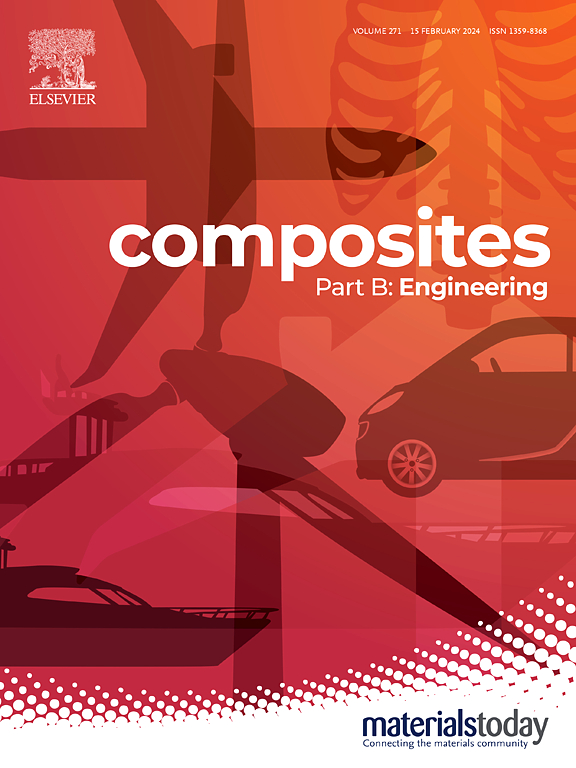Achieving the simultaneous improvement of degradation, thermal, and mechanical properties of polylactic acid composite films by carbon quantum dots
IF 12.7
1区 材料科学
Q1 ENGINEERING, MULTIDISCIPLINARY
引用次数: 0
Abstract
Having porous structure, large surface area, and high carbon content of biochar facilitates interface bonding of polylactic acid (PLA) composites, but uneven dispersion by its irregular morphology is becoming a new challenge in damaging properties. Based on this, the novelty of this study is using carbon quantum dots (CQDs) to overcome the performance defects of caused PLA composites by biochar while the ultimate goal is to reveal the influence mechanism of CQDs on structure, characteristics, and properties of PLA composites based on disclosing the forming mechanism of CQDs. It was found that adding CQDs accelerated the degradation of PLA from the results of Phosphate Buffer Saline (PBS) degradation, hydrolysis, and soil degradation. PLA/CQDs composite films also showed better thermal properties due to the excellent thermal stability of CQDs, and nucleation effect of CQDs should be responsible for the improvement of PLA crystallization. Additionally, having good activity, regular morphology, and uniform size of CQDs facilitated uniform dispersion and good interface combination in PLA system and thereby improved the tensile strength, tensile modulus, and elongation at break simultaneously. As a comparison, the tensile strength, tensile modulus, and elongation at break of 1 wt% PLA/CQDs composite films are 55.00 MPa, 1.76 GPa, and 9.84 %, this provides a promising, sustainable, and eco-friendly solution for reinforcing PLA composites.
利用碳量子点同时改善了聚乳酸复合薄膜的降解性能、热性能和力学性能
生物炭具有多孔结构、大表面积和高含碳量,有利于聚乳酸(PLA)复合材料的界面键合,但其不规则形态导致的不均匀分散成为破坏性能的新挑战。基于此,本研究的新颖之处是利用碳量子点(CQDs)来克服生物炭导致PLA复合材料性能缺陷,最终目的是在揭示CQDs形成机理的基础上,揭示CQDs对PLA复合材料结构、特性和性能的影响机理。从磷酸缓冲盐(PBS)降解、水解和土壤降解的结果发现,添加CQDs加速了PLA的降解。由于CQDs具有优异的热稳定性,PLA/CQDs复合薄膜表现出较好的热性能,CQDs的成核效应可能是PLA结晶性能改善的原因。此外,CQDs具有良好的活性、规则的形貌和均匀的尺寸,有利于在PLA体系中均匀分散和良好的界面结合,从而同时提高拉伸强度、拉伸模量和断裂伸长率。相比之下,1 wt% PLA/CQDs复合膜的拉伸强度、拉伸模量和断裂伸长率分别为55.00 MPa、1.76 GPa和9.84%,这为增强PLA复合材料提供了一种有前途的、可持续的、环保的解决方案。
本文章由计算机程序翻译,如有差异,请以英文原文为准。
求助全文
约1分钟内获得全文
求助全文
来源期刊

Composites Part B: Engineering
工程技术-材料科学:复合
CiteScore
24.40
自引率
11.50%
发文量
784
审稿时长
21 days
期刊介绍:
Composites Part B: Engineering is a journal that publishes impactful research of high quality on composite materials. This research is supported by fundamental mechanics and materials science and engineering approaches. The targeted research can cover a wide range of length scales, ranging from nano to micro and meso, and even to the full product and structure level. The journal specifically focuses on engineering applications that involve high performance composites. These applications can range from low volume and high cost to high volume and low cost composite development.
The main goal of the journal is to provide a platform for the prompt publication of original and high quality research. The emphasis is on design, development, modeling, validation, and manufacturing of engineering details and concepts. The journal welcomes both basic research papers and proposals for review articles. Authors are encouraged to address challenges across various application areas. These areas include, but are not limited to, aerospace, automotive, and other surface transportation. The journal also covers energy-related applications, with a focus on renewable energy. Other application areas include infrastructure, off-shore and maritime projects, health care technology, and recreational products.
 求助内容:
求助内容: 应助结果提醒方式:
应助结果提醒方式:


